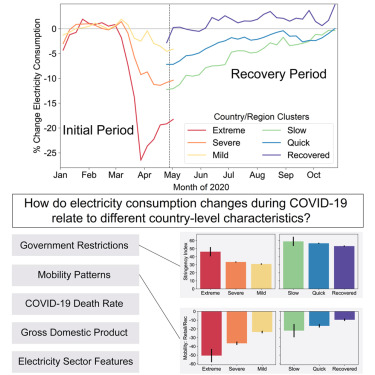Global electricity consumption plummeted an unprecedented amount during the first six weeks of the COVID-19 pandemic. Just six months later it had recovered fully. Moreover, factors that were strongly associated with initial declines in electricity use were not tightly linked to its rebound.
That’s what a team of Stanford University and Oregon State University researchers found in a study published online by the journal iScience in January. In April 2020, at the beginning of the COVID-19 pandemic, electricity consumption had declined by 7.6 percent across the globe, which was larger and much more rapid than the 7 percent drop seen during the 2008 global financial crisis. Apparent causes of early consumption reductions—like government restrictions on in-person work, schooling, travel and social interaction, as well as declines in personal mobility and economic production—were much less correlated with recovery times. In general, the larger a country’s initial decrease in consumption, the slower it recovered, with the extreme examples being India and Italy.
“Our question was: How is the global electricity system responding to the pandemic?” said Ram Rajagopal, senior co-author of the study and an associate professor in the Department of Civil & Environmental Engineering at Stanford. “We focused specifically on electricity consumption due to changes in habits and behavior throughout the pandemic.”
A global scale
The team of researchers drew their conclusions from a pool of data encompassing 58 countries and regions within countries, 60 percent of the world’s population and 75 percent of global electricity use. The initial decline was usually heavily correlated with the stringency of a government’s lockdown. Due to stay-at-home orders and consequential reduced mobility, residential consumption increased, while commercial and industrial consumption decreased, leading to a net reduction in usage.
Other factors, like geography, were not so strongly correlated. Declines varied among countries in the same continent and among regions in the same country. Nearly every continent saw at least one country’s electricity use decline dramatically and at least one country’s use remain nearly unaffected. In South America, Argentina took a big hit while Chile’s consumption was about the same. In the United States, the Carolinas saw a severe drop, while declines were mild in New England and the Northeast.
Researchers did not expect electricity use to rebound so quickly. Nor did they expect that factors associated strongly with decline would delink from patterns of recovery.
“By September or October 2020, global consumption had recovered. This was surprising, especially because a lot of countries still had restrictions in place. It seems as though changes in electricity use were most tightly linked to restriction levels early in the pandemic, but they decoupled as consumption recovered,” said Lily Buechler, a Ph.D. candidate and one of two lead student researchers of the study.
People likely began to deviate from habits initially adopted by returning to work and school, shopping and socializing more regardless of changes in government restrictions, the researchers think.
Searching for an explanation
The study considered several factors that could have contributed to the recovery of consumption rates.
“The magnitude of change was not necessarily related to the magnitude of restrictions or mobility changes. That’s what people had expected before, but it turned out those were not the best predictors,” said Rajagopal.
Lower gross domestic product (GDP) seemed to be linked to initial reductions in power use, but not to the rebounds in countries’ power use.
“I think the pattern reflects that the world has changed,” said Siobhan Powell, co-lead author of the study with Buechler. “The pandemic affected the connection between economic activity and electricity use as many people shifted to new ways of working. The different world we found ourselves in during the second half of 2020 was reflected in the relationships in this study.”
India and Italy stood out in their respective regions as having the most severe declines in electricity use, averaging 26 percent at their lowest point in late March. They were also among the countries with the slowest return to pre-pandemic consumption levels. Their average consumption returned to within 5 percent of forecasted use in July. In contrast, power consumption in quick-recovering countries, which usually had a less severe initial drop, recovered before the end of May.
In terms of geographic scope, the study was the largest to examine pandemic electricity patterns. While several previous studies attempted to estimate the effects of the pandemic, most of their data had been limited to countries where data was the most readily available, primarily in the United States and Europe.
Moving forward
The team sees many future applications for their research.
“It’s actually unusual to have an event like the pandemic that affects so many different countries at the same time. It gave us an interesting opportunity to compare responses among countries that experienced very different COVID-related policies,” said Buechler.
“One of the applications of our study is in preparing for future shocks to electricity systems,” said Powell.
As climate change causes more and more unpredictable phenomena across the globe, it is important that power systems can handle the shock of sudden, sweeping changes in electricity consumption. In order to build resilience to events that may affect grid operation and forecasting, electricity system operators need to understand and anticipate the effects of such events,
“If utilities could make use of what we’ve uncovered here about how electricity consumption changes when things are shut down, they could be better informed about what will happen when things may shut down in the future because of the pandemic or other crises,” said Hilary Boudet, Ph.D. ’10, senior co-author, and associate professor of sociology and public policy at Oregon State.
The researchers hope their work continues to contribute to that understanding. They have released their code and data with the hope that other researchers can use their results to further analyze the pandemic’s impacts on the power system, explained Buechler.
Other co-authors of this study—all at Stanford—are June Flora, senior research scholar; Tao Sun, Ph.D. student; and postdoctoral scholars Chad Zanocco, Jose Bolorinos and Nicolas Astier (former).
More information:
Elizabeth Buechler et al, Global changes in electricity consumption during COVID-19, iScience (2021). DOI: 10.1016/j.isci.2021.103568
Provided by
Stanford University
Citation:
Speed and surprises: Decline and recovery of global electricity use in COVID’s first seven months (2022, February 11)



